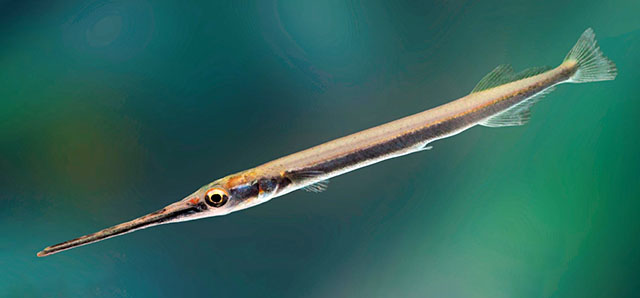Xenentodon cancila (Hamilton, 1822)
Freshwater garfish |
|
Freshwater garfish,
Kakila,
Chowkli,
Kakiya,
Kankely,
Kokila,
Kokkare,
Kokkumeen,
Kolaan,
Konti,
Kutramasa,
Ngachek lawbi,
Tokali,
Vellai mooral,
सुई,
கொக்கு மீன்,
வெள்ளை மூரல்,
കോലാന്
|
| Belonidae (Needlefishes) |
| 40 cm TL (male/unsexed) |
|
pelagic-neritic; freshwater; brackish; pH range: 7 - 7.5; dH range: 20; depth range 0 - 2 m, amphidromous |
| Asia: Sri Lanka and India eastward to the Mekong. |
|
Dorsal spines (total): 0-0; Dorsal soft rays (total): 15-18; Anal spines: 0-0; Anal soft rays: 16-18. Body very elongate and slightly compressed. Dorsal fin inserted usually anterior to a vertical through the origin of the anal fin. Green-silvery dorsally, grading to whitish below. A silvery band with a dark margin run along the side; a series of four or five blotches (absent in young specimens) on sides between the pectoral and anal fins. Dorsal and anal fins with dark edges. |
| Adults occur primarily in rivers (Ref. 4833); also in ponds, canals, beels, and inundated fields (Ref. 1479). Often found in slow-flowing pools in rivers with a rock or sand substrate (Ref. 6028). They inhabit large and medium-sized rivers with adults occurring in areas that lack floating vegetation (Ref. 12693). A solitary species that swims in midwater, usually against the current, and is capable of bursts of speed, especially when in pursuit of its prey. Observed to feed exclusively on crustaceans in the wild; but take live fish only when in an aquarium (Ref. 6028). Also feeds on small fishes and insects (Ref. 12693). Oviparous (Ref. 205). Eggs may be found attached to objects in the water by tendrils on the egg's surface (Ref. 205). This fish is capable of nipping the fingers or killing a person by leaping at them at great speed (Ref. 6028; Kullander (pers. comm., 2001), however, suggests that the "killing a person" statement may be exaggerated). Marketed fresh (Ref. 12693). |
|
Least Concern (LC); Date assessed: 12 August 2019 Ref. (130435)
|
| traumatogenic |
|
Known throughout India (Ref. 41236). Recorded from Chilka Lake (Ref. 29108); Western Ghats Rivers, Maharashtra (Ref. 43634); Kallar, Bhavani, Moyar, Tamil Nadu (Ref. 44148); Agartala, Tripura (Ref. 97593). It occurs in clear, gravelly, perennial streams and ponds of Terai and Duars, North Bengal. It is fairly common in the Ganges-Brahmaputra system (Ref. 4833). Present in Buxa, Adma and Jayanti rivers (Ref. 89719), Manjeswarm River, Tungabhadra river and riversystems of Kerala (Ref. 92228). Utilized as food by the tribal people, "Kanis" of Kanyakumari District (Ref. 45217). Also Ref. 36654, 43640, 45204, 45255, 87807.
Status of threat: Low risk in Western Ghats (Ref. 50614). |
Source and more info: www.fishbase.org. For personal, classroom, and other internal use only. Not for publication.

